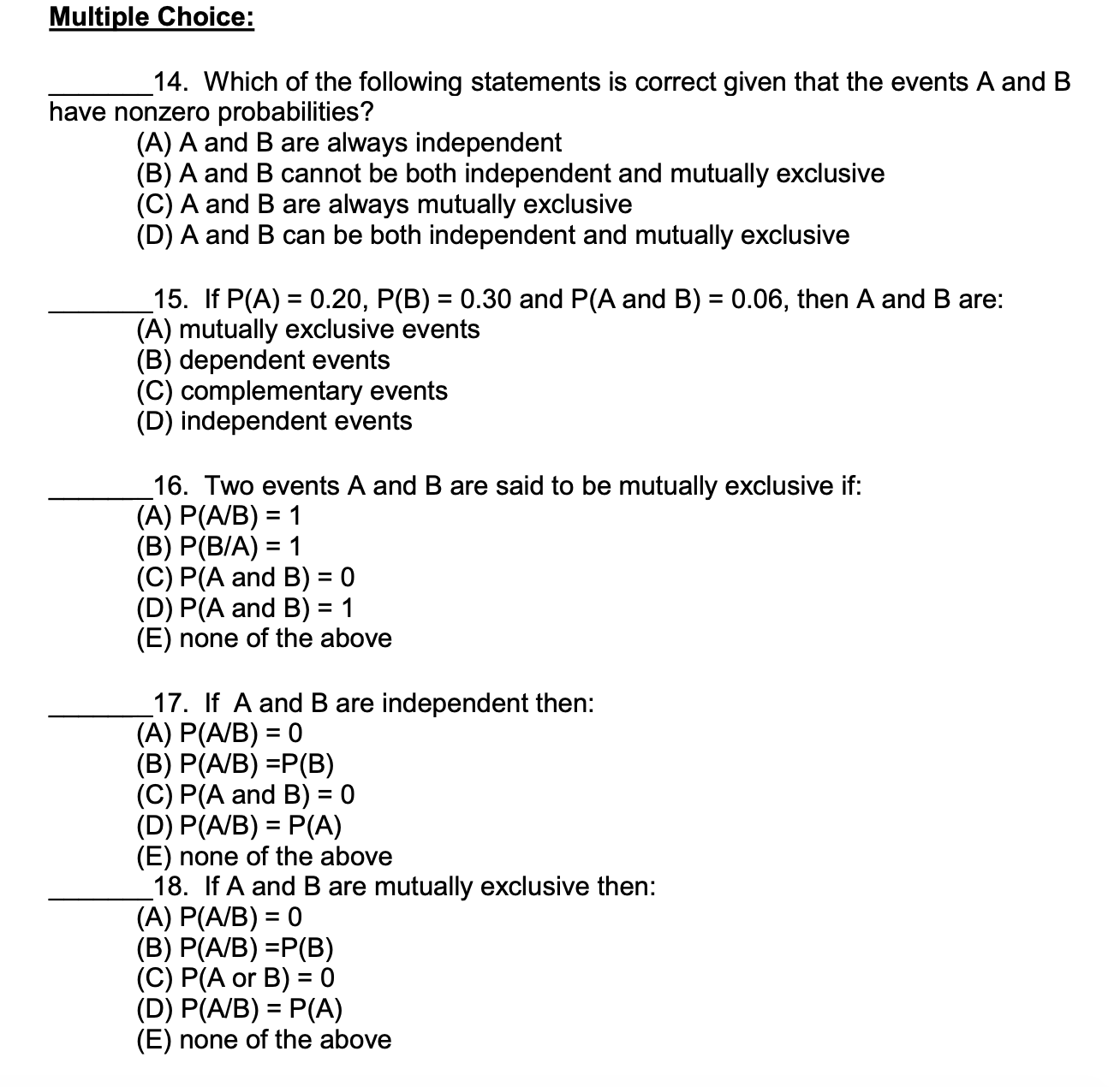14. Which of the following statements is correct given that the events A and B have nonzero probabilities? (A) A and B are always independent (B) A and B cannot be both independent and mutually exclusive (C) A and B are always mutually exclusive (D) A and B can be both independent and mutually exclusive 15. If P(A) = 0.20, P(B) = 0.30 and P(A and B) = 0.06, then A and B are: (A) mutually exclusive events (B) dependent events (C) complementary events (D) independent events 16. Two events A and B are said to be mutually exclusive if: (A) P(A/B) = 1 (B) P(B/A) = 1 (C) P(A and B) = 0 (D) P(A and B) = 1 (E) none of the above %3D %3D _17. If A and B are independent then: (A) P(A/B) = 0 (B) P(A/B) =P(B) (C) P(A and B) = 0 (D) P(A/B) = P(A) (E) none of the above _18. If A and B are mutually exclusive then: (A) P(A/B) = 0 (B) P(A/B) =P(B) (C) P(A or B) = 0 (D) P(A/B) = P(A) (E) none of the above %3D %3D
14. Which of the following statements is correct given that the events A and B have nonzero probabilities? (A) A and B are always independent (B) A and B cannot be both independent and mutually exclusive (C) A and B are always mutually exclusive (D) A and B can be both independent and mutually exclusive 15. If P(A) = 0.20, P(B) = 0.30 and P(A and B) = 0.06, then A and B are: (A) mutually exclusive events (B) dependent events (C) complementary events (D) independent events 16. Two events A and B are said to be mutually exclusive if: (A) P(A/B) = 1 (B) P(B/A) = 1 (C) P(A and B) = 0 (D) P(A and B) = 1 (E) none of the above %3D %3D _17. If A and B are independent then: (A) P(A/B) = 0 (B) P(A/B) =P(B) (C) P(A and B) = 0 (D) P(A/B) = P(A) (E) none of the above _18. If A and B are mutually exclusive then: (A) P(A/B) = 0 (B) P(A/B) =P(B) (C) P(A or B) = 0 (D) P(A/B) = P(A) (E) none of the above %3D %3D
A First Course in Probability (10th Edition)
10th Edition
ISBN:9780134753119
Author:Sheldon Ross
Publisher:Sheldon Ross
Chapter1: Combinatorial Analysis
Section: Chapter Questions
Problem 1.1P: a. How many different 7-place license plates are possible if the first 2 places are for letters and...
Related questions
Topic Video
Question
I need help on this multiple choice question please: 14 to 18 please

Transcribed Image Text:14. Which of the following statements is correct given that the events A and B
have nonzero probabilities?
(A) A and B are always independent
(B) A and B cannot be both independent and mutually exclusive
(C) A and B are always mutually exclusive
(D) A and B can be both independent and mutually exclusive
15. If P(A) = 0.20, P(B) = 0.30 and P(A and B) = 0.06, then A and B are:
(A) mutually exclusive events
(B) dependent events
(C) complementary events
(D) independent events
16. Two events A and B are said to be mutually exclusive if:
(A) P(A/B) = 1
(B) P(B/A) = 1
(C) P(A and B) = 0
(D) P(A and B) = 1
(E) none of the above
%3D
%3D
_17. If A and B are independent then:
(A) P(A/B) = 0
(B) P(A/B) =P(B)
(C) P(A and B) = 0
(D) P(A/B) = P(A)
(E) none of the above
_18. If A and B are mutually exclusive then:
(A) P(A/B) = 0
(B) P(A/B) =P(B)
(C) P(A or B) = 0
(D) P(A/B) = P(A)
(E) none of the above
%3D
%3D
Expert Solution
This question has been solved!
Explore an expertly crafted, step-by-step solution for a thorough understanding of key concepts.
This is a popular solution!
Trending now
This is a popular solution!
Step by step
Solved in 2 steps

Knowledge Booster
Learn more about
Need a deep-dive on the concept behind this application? Look no further. Learn more about this topic, probability and related others by exploring similar questions and additional content below.Recommended textbooks for you

A First Course in Probability (10th Edition)
Probability
ISBN:
9780134753119
Author:
Sheldon Ross
Publisher:
PEARSON


A First Course in Probability (10th Edition)
Probability
ISBN:
9780134753119
Author:
Sheldon Ross
Publisher:
PEARSON
